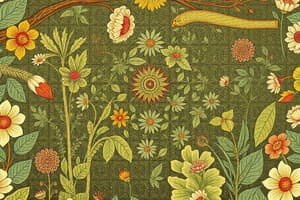Podcast
Questions and Answers
What is biology?
What is biology?
The science of life forms and living processes.
Which of the following is a feature of both living and non-living objects?
Which of the following is a feature of both living and non-living objects?
- Sense of awe or fear (correct)
- Ability to reproduce
- Sense of beauty
- Metabolism
Who was Ernst Mayr?
Who was Ernst Mayr?
A Harvard University evolutionary biologist known as 'The Darwin of the 20th century.'
Ernst Mayr was awarded the Balzan Prize in 1994.
Ernst Mayr was awarded the Balzan Prize in 1994.
In what year was Ernst Mayr born?
In what year was Ernst Mayr born?
Ernst Mayr died at the age of ______.
Ernst Mayr died at the age of ______.
What did Mayr almost single-handedly make the central question of?
What did Mayr almost single-handedly make the central question of?
Flashcards are hidden until you start studying
Study Notes
Diversity in the Living World
- Biology studies life forms and processes, encompassing an extraordinary variety of living organisms.
- Early humans distinguished inanimate matter from living organisms, attributing divine qualities to both natural elements and certain animals or plants.
- Awe and fear elicited by these entities played a significant role in early human society's understanding of the living world.
- Comprehensive descriptions of organisms began later in history, influencing societal progress in biology.
- An anthropocentric view limited understanding; systematic classification and nomenclature revealed relationships among organisms.
- Discoveries emphasized that all living organisms, past and present, share common ancestry, promoting biodiversity conservation movements.
Ernst Mayr
- Born on July 5, 1904, in Kempten, Germany; considered 'The Darwin of the 20th century'.
- Contributed significantly to evolutionary biology while at Harvard University, becoming a Professor of Zoology Emeritus in 1975.
- Conducted extensive research in ornithology, taxonomy, zoogeography, evolution, and the philosophy of biology.
- Centralized species diversity as a key question in evolutionary biology.
- Authored the widely accepted definition of biological species.
- Received prestigious awards: Balzan Prize (1983), International Prize for Biology (1994), and Crafoord Prize (1999).
- Died at the age of 100 in 2004.
Characteristics of Living Organisms
- The diversity of life is exemplified in various habitats such as mountains, forests, oceans, lakes, deserts, and springs.
- Living forms evoke a sense of wonder, from galloping horses to migrating birds.
- Ecological interactions, including competition and cooperation, deepen our understanding of life.
- The question of what constitutes life encompasses both technical and philosophical dimensions; the latter, concerning purpose, remains unanswered in the scientific realm.
- A rich variety of visible and microscopic organisms demonstrates the vastness of life forms in our environment.
Studying That Suits You
Use AI to generate personalized quizzes and flashcards to suit your learning preferences.




